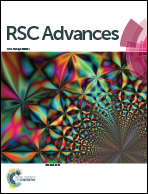Eu3+:Y2O3@CNTs—a rare earth filled carbon nanotube nanomaterial with low toxicity and good photoluminescence properties
Abstract
Red-emission phosphor europium-doped yttria (Eu3+:Y2O3) nanoparticles have been successfully filled into the nanocavity of carbon nanotubes (CNTs) via supercritical reaction and supercritical fluids followed by calcination. The existence of Eu3+:Y2O3 nanoparticles inside CNTs was characterized by TEM, EDS and XRD. The as-prepared nanomaterials (Eu3+:Y2O3@CNTs) exhibited strong red-emission at 610 nm, which corresponded to 5D0 → 7F2 transition within Eu3+ ions. It showed that the existence of the walls of the CNTs did not quench the luminescence of Eu3+:Y2O3. Due to the surface modification with Tween 80, Eu3+:Y2O3@CNTs had good water solubility. In vitro cytotoxicity studies showed that the as-prepared nanomaterials had low toxicity on HeLa cells at concentrations of 10–1000 μg mL−1. And their use as luminescence probes for live cell imaging was demonstrated by using inverted fluorescence microscopy. With the advantages of the easy dispersion in water, low toxicity, and good photoluminescence (PL) properties, the as-prepared Eu3+:Y2O3@CNTs could potentially be used as nanophosphors in bio-imaging.


 Please wait while we load your content...
Please wait while we load your content...